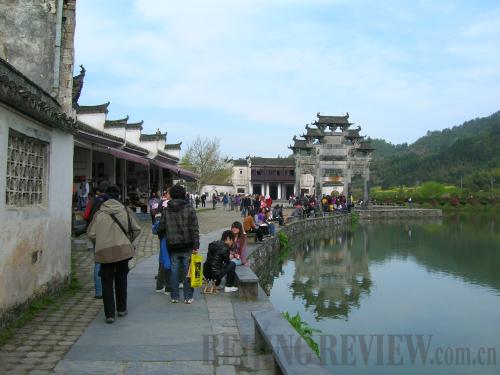|
Xidi charming
 |
|
LIVING MUSEUM: A well-preserved ancient village in Huangshan City, Xidi has been drawing a growing number of tourists due to its unique architecture and natural surroundings LI LI | A large amount of Huizhou-style architecture, featuring high white walls, dark eaves, tiny windows and abundant use of brick, wood and stone carvings for decoration, has been well preserved due to local geography, which made village communities isolated and gave them effective protection from outside aggression.
Xidi is one such village, and is surrounded by mountains on all four sides. With a history of 960 years, the village in Shexian County, which is a part of old Huizhou, was declared a part of the "Ancient Villages in Southern Anhui" world heritage site by UNESCO in 2000. The village boasts more than 150 well-preserved houses built during the Ming and Qing dynasties, four family temples and one memorial archway for the ancestor of the village's Hu clan, who was a senior government official in the 16th century.
The village was opened as a tourist destination in the early 1980s. "Local people's living conditions have improved dramatically due to the tourism boom," said Tang Guoqiang, head of the village.
In 2009 alone, 560,000 tourists visited the village of 1,100 people. Of the 22 million yuan ($3.24 million) made from selling tickets alone, 17 percent was directly divided amongst villagers.
To preserve the ancient buildings, when a family wants to repair or renovate their house they must first lodge an application with the county-level cultural heritage protection authorities. The whole process includes nine procedures, and the work is performed by construction companies who specialize in repairing ancient architecture. The local government pays 40 percent of the repair expenses.
Xidi's administrative committee is fully aware of the strain placed by tourism on environmental and heritage protection efforts. Cheng Dan, acting director of the committee, said that during the tourist season, they often have to open emergency exits and make most of the alleys in the village one-way, in order to disperse tourist traffic. Cheng said that more than 11,000 people visited the 16-hectare village on its busiest day.
"In 2004, when the village acquired 180 licenses for souvenir shops, restaurants and hotels, we decided to stop issuing new licenses. After all, we don't want to turn this lovely village into a supermarket," said Cheng.
Chinese Properties Inscribed on the World Heritage List Cultural
1. The Great Wall (Beijing, 1987)
2. Imperial palaces of the Ming and Qing dynasties in Beijing and Shenyang (the Forbidden City, Beijing, 1987; Imperial Palace of the Qing Dynasty, Shenyang, Liaoning Province, 2004)
3. Peking Man Site at Zhoukoudian (Beijing, 1987)
4. Mogao Caves (Gansu Province, 1987)
5. Mausoleum of the First Qin Emperor (Shaanxi Province, 1987)
6. Mountain resort and its outlying temples, Chengde (Hebei Province, 1994)
7. Historic ensemble of the Potala Palace, Lhasa (Tibet Autonomous Region, 1994)
8. Temple and cemetery of Confucius and the Kong Family Mansion in Qufu (Shandong Province, 1994)
9. Ancient building complex in the Wudang Mountain (Hubei Province, 1994)
10. Lushan National Park (Jiangxi Province, 1996)
11. Ancient city of Pingyao (Shanxi Province, 1997)
12. Classical gardens of Suzhou (Jiangsu Province, 1997)
13. Old town of Lijiang (Yunnan Province, 1997)
14. Summer Palace, an imperial garden in Beijing (Beijing, 1998)
15. Temple of Heaven, an imperial sacrificial altar in Beijing (Beijing, 1998)
16. Dazu Rock Carvings (Chongqing Municipality, 1999)
17. Imperial mausoleums of the Ming and Qing dynasties (Ming Xianling Mausoleum, Hubei Province, 2000; Qing Dongling Mausoleum and Qing Xiling Mausoleum, Hebei Province, 2000; Ming Tombs, Beijing, 2003; Ming Xiaoling Mausoleum, Jiangsu, 2003; three imperial mausoleums of Shengjing, Liaoning Province, 2004)
18. Longmen Grottoes (Henan Province, 2000)
19. The Qingcheng Mountain and the Dujiangyan Irrigation System (Sichuan Province, 2000)
20. Ancient villages in southern Anhui-Xidi and Hongcun (Anhui Province, 2000)
21. Yungang Grottoes (Shanxi Province, 2001)
22. Capital cities and tombs of the Ancient Koguryo Kingdom (Liaoning and Jilin provinces, 2004)
23. Historic center of Macao (Macao Special Administrative Region, 2005)
24. Yinxu (Henan Province, 2006)
25. Kaiping Diaolou and villages (Guangdong Province, 2007)
26. Fujian Tulou (Fujian Province, 2008)
27. Wutai Mountain (Shanxi Province, 2009)
Natural
28. Huanglong Scenic and Historic Interest Area (Sichuan Province, 1992)
29. Jiuzhaigou Valley Scenic and Historic Interest Area (Sichuan Province, 1992)
30. Wulingyuan Scenic and Historic Interest Area (Hunan Province, 1992)
31. Three Parallel Rivers of Yunnan Protected Areas (Yunnan Province, 2003)
32. Sichuan giant panda sanctuaries-Wolong, Siguniang Mountain and Jiajin Mountain (Sichuan Province, 2006)
33. South China Karst (Yunnan Province, Guizhou Province and Chongqing Municipality, 2007)
34. The Sanqing Mountain National Park (Jiangxi Province, 2008)
Mixed
35. Taishan Mountain (Shandong Province, 1987)
36. Huangshan Mountain (Anhui Province, 1990)
37. Emei Mountain Scenic Area, including Leshan Giant Buddha Scenic Area (Sichuan Province, 1996)
38. Wuyi Mountain (Fujian Province, 1999)
(Source: UNESCO)
| 